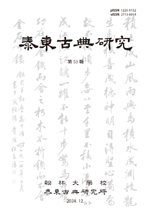퇴계 이황의 점서관(占筮觀)과 점법(占法) 연구
The Study on Toegye Yi Hwang's Perspective on Divination(占筮) and Divinatory Methods
- 한림대학교 태동고전연구소
- 태동고전연구
- 제53집
-
2024.12123 - 153 (31 pages)
-
DOI : 10.31408/tdicr.2024.53.123
- 12

본 연구는 이황의 점서관과 점법을 분석하여 그의 점(占)에 대한 관점을 알아보고자 한다. 주지하듯이 이황은 주자학을 기반으로 『주역』과 점서(占筮)를 연구하였으며 점법 해석에 주목하였다. 그가 점을 연구한 이유는 점을 신(神)의 현현으로 보았고, 이것이 리(理)가 기(氣)를타고 있는 형상이라고 여겼기 때문이라 추정된다. 즉, 이황은 점을 단순히 미래를 예측하는수단이 아닌 도덕적 실천과 우주의 이치를 탐구하는 방법으로 생각했다. 그렇기에 그는 『계몽전의』에서 점법에 대한 다양한 견해를 추가하였으며, 척전법과 같은 독특한 점법도 기록하였다. 그러나 점을 치는 방법에 있어서는 옛 성인들이 창안했던 복서(卜筮)를 근본으로 여겼다. 비록 이황은 점을 치지 않았지만, 점범을 연구하여 리기의 현현을 탐구하였다.
This study examines Yi Hwang's views on divination texts and methods to explore his perspective on divination. As widely recognized, Yi Hwang's research was rooted in Zhu Xi's Confucianism, with a focus on the I Ching a nd its divinatory interpretations. However, his interest in divination was deeply tied to his belief that divination manifested the divine (神), which he understood as the expression of li (理) carried by qi (氣). Thus, Yi Hwang perceived divination not merely as a tool for predicting the future but as a means of exploring moral practice and the fundamental principles of the universe. In line with this perspective, he incorporated various views on divinatory methods in his work Recording the Questions Regarding Introduction to the Study of the Changes (Gyemong jeonui, 啓蒙傳疑), where he also documented unique practices such as the coin divination method (cheokjeonbeop, 擲錢法). Nevertheless, he regarded the Bushi (卜筮), created by the ancient sages, as the most foundational method of divination. Although Yi Hwang did not engage in the practice of divination himself, he studied its methods to explore how Li (理) and Qi (氣) interact or are manifested.
1. 서론
2. 이황의 점서관(占筮觀) - 주자(朱子)와의 비교
3. 『계몽전의』에 기술된 이황의 점법
4. 결론
(0)
(0)